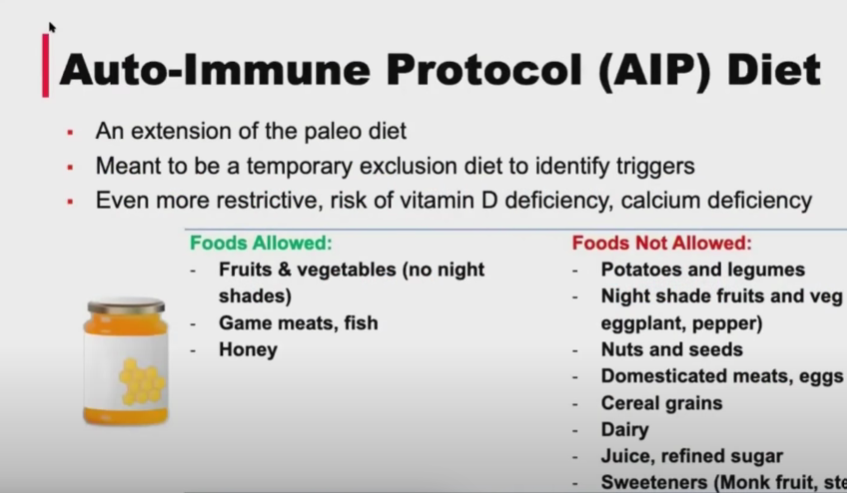The autoimmune protocol diet may help individuals with autoimmune diseases—such as lupus, rheumatoid arthritis, or psoriasis—identify and avoid specific foods that increase symptoms like inflammation. Discover the costs, benefits, and other details of the AIP diet. This is not a ranking diet.
What is the Autoimmune Protocol Diet?
The autoimmune protocol diet, or autoimmune paleo diet, is abbreviated as the Autoimmune Protocol. The hybrid diet blends elements of the paleo diet with elimination diets, which are meant to cut down on items that can cause disease. AIP was created with the goal of easing the symptoms of autoimmune diseases and reducing inflammation by removing items that frequently irritate the gut or promote inflammation. These common ailments are brought on by an immune system that has wrongly attacked healthy tissue in the body, leading to inflammation and other issues like pain, swelling, exhaustion, and skin changes. These illnesses frequently have periods of remission when symptoms lessen, interspersed with flare-ups at times when symptoms are at their worst.
You cautiously reintroduce foods one at a time while following the Autoimmune Protocol diet to observe how your body responds. This makes it easier to determine if a certain meal is safe to eat or should be avoided completely. After talking with your doctor, you may want to think about the Autoimmune Protocol diet if you have an autoimmune disease, such as lupus, rheumatoid arthritis, psoriasis, inflammatory bowel disease, or Hashimoto’s thyroiditis. There hasn’t been much research done on it, and it’s a highly rigid diet that not everyone should follow.
Also read-Dr. Weil’s Anti-Inflammatory Diet

- Low in carbohydrates. Diets low in carbohydrates provide a lot fewer calories from carbohydrates than the 45% to 65% recommended by the government.
- Favorable to those without gluten. It’s simple to alter recipes while maintaining a gluten-free diet.
- Halal friendly. It is simple to alter recipes while maintaining a halal diet.
- Friendly to Kosher? It’s simple to alter recipes while maintaining a kosher diet.

How does the Autoimmune Protocol diet work?
- Make an effort to consume more anti-inflammatory foods, such as fermented foods like kefir, kombucha, and fresh vegetables.
- For a duration of 30 to 90 days, a person must strictly abstain from items that provoke symptoms, such as nightshade vegetables (tomatoes, peppers, eggplants, and potatoes), cereals, nuts, and seeds, eggs, dairy products, and more. Additionally, some AIP protocols request that adherents avoid fruit throughout this period.
- Avoidable substances include alcohol, tobacco, added sugar, food additives, caffeine, and even some prescription drugs.
- You will eventually reintroduce foods one by one while monitoring any changes in your health and symptoms.
- There are also discussions about stress, sleep, and exercise.

Can I lose weight on the Autoimmune Protocol diet?
Since the AIP diet focuses on identifying pro-inflammatory foods rather than weight loss, it’s possible that you won’t lose weight. As a side effect of AIP, you may lose weight by avoiding a variety of foods, such as dairy products, food additives, and alcoholic beverages. It depends on the specific adjustments a person makes, according to Madison, Wisconsin-based registered dietician Camila Martin of UW Health. “We could lose some weight if we’re not eating cakes, cookies, or highly processed grains,” adds Martin. However, we may observe the reverse if we replace our nuts and seeds, which can satisfy our hunger and maintain our energy levels so that we have the energy to work out.

Short-Term Weight Loss
In a 2015 analysis of four randomized clinical studies with 159 participants, researchers discovered that over the course of six months, paleo diet followers shed more weight and saw more appreciable improvements in their waistline measures than those following a conventional control diet.
Long-Term Weight Loss
In a 2015 analysis of four randomized clinical studies with 159 participants, researchers discovered that over the course of six months, paleo diet followers shed more weight and saw more appreciable improvements in their waistline measures than those following a conventional control diet.

Weight Maintenance and Management
In the 2014 study of 70 women mentioned above, participants in both the paleo and low-fat diet groups regained some weight at the two-year mark. However, paleo participants still weighed 10 pounds less than when they started the study.

Also read-Diet And Arthritis: What To Avoid In Foods For Good Health And Happy Life
images source: Google
Disclaimer: The opinions and suggestions expressed in this article are solely those of the individual analysts. These are not the opinions of HNN. For more, please consult with your doctor




































